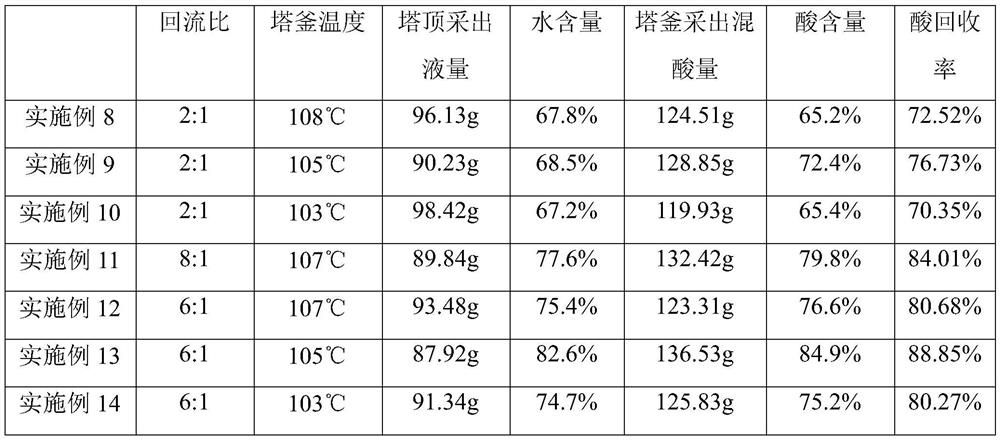Method for recycling waste aluminum etching solution
An aluminum etching and solution technology, applied in chemical instruments and methods, separation/purification of carboxylic acid compounds, inorganic chemistry, etc., can solve the problems of difficult effective separation by ordinary distillation methods, unstable heating of nitric acid, waste of resources and solid waste, etc. , to avoid waste of resources and environmental pollution, improve rectification processing capacity, and improve economic benefits
- Summary
- Abstract
- Description
- Claims
- Application Information
AI Technical Summary
Problems solved by technology
Method used
Image
Examples
Embodiment 1
[0021] Get waste aluminum etching solution 1000g, its main chemical composition and content are as follows:
[0022] chemical composition H3PO4 HNO3 CH3COOH H2O Content (mass fraction) 69.6% 4.9% 10.3% 15.2%
[0023] Follow the steps below to recycle the waste aluminum etching solution:
[0024] (1) Add the waste aluminum etching solution to the tower kettle, turn on the vacuum pump to adjust the vacuum degree to 0.1MPa, start to heat slowly at a stirring speed of 100rpm, and control the temperature at about 100°C, due to the boiling points of phosphoric acid, nitric acid, and acetic acid The volatility is very different. The mixed acid of nitric acid and acetic acid was separated from the waste aluminum etching solution by fractional distillation, and 229.67g of distillate was collected, and 767.54g of tower bottom liquid was collected. After testing, the phosphoric acid content in the tower bottom liquid is about 90.6%.
[0025] (2) The main ...
Embodiment 2
[0031] Get waste aluminum etching solution 1000g, its main chemical composition and content are as follows:
[0032] chemical composition H3PO4 HNO3 CH3COOH H2O Content (mass fraction) 50.8% 10.3% 15.9% 23.0%
[0033] According to the following steps, the mixed acid in the waste aluminum etching solution is recycled:
[0034] (1) Add 1000g of waste aluminum etching solution to the tower kettle, turn on the vacuum pump to adjust the vacuum degree to 0.1MPa, slowly heat and distill at a stirring speed of 100rpm, and control the temperature at about 120°C for 2 hours, due to phosphoric acid and nitric acid, acetic acid The boiling point and volatility of the distillate are very different. The nitric acid and acetic acid mixed solution was separated from the waste aluminum etching solution by fractional distillation, and 437.35g of distillate and 559.23g of tower bottom liquid were collected. After testing, the content of phosphoric acid in the towe...
Embodiment 3
[0042] Get waste aluminum etching solution 1000g, its main chemical composition and content are as follows:
[0043] chemical composition H3PO4 HNO3 CH3COOH H2O Content (mass fraction) 69.2% 4.6% 10.5% 15.7%
[0044] According to the following steps, the mixed acid in the waste aluminum etching solution is recycled:
[0045] (1) Add 1000g of waste aluminum etching solution to the tower kettle, turn on the vacuum pump to adjust the vacuum degree to 0.1MPa, slowly heat and distill at a stirring speed of 100rpm, and control the temperature at about 120°C for 2 hours, due to phosphoric acid and nitric acid, acetic acid The boiling point and volatility of the distillate are very different. The nitric acid and acetic acid mixed solution was separated from the waste aluminum etching solution by fractional distillation, and 226.18g of distillate and 771.43g of tower bottom liquid were collected. After testing, the phosphoric acid content in the tower bo...
PUM
 Login to View More
Login to View More Abstract
Description
Claims
Application Information
 Login to View More
Login to View More - R&D Engineer
- R&D Manager
- IP Professional
- Industry Leading Data Capabilities
- Powerful AI technology
- Patent DNA Extraction
Browse by: Latest US Patents, China's latest patents, Technical Efficacy Thesaurus, Application Domain, Technology Topic, Popular Technical Reports.
© 2024 PatSnap. All rights reserved.Legal|Privacy policy|Modern Slavery Act Transparency Statement|Sitemap|About US| Contact US: help@patsnap.com









